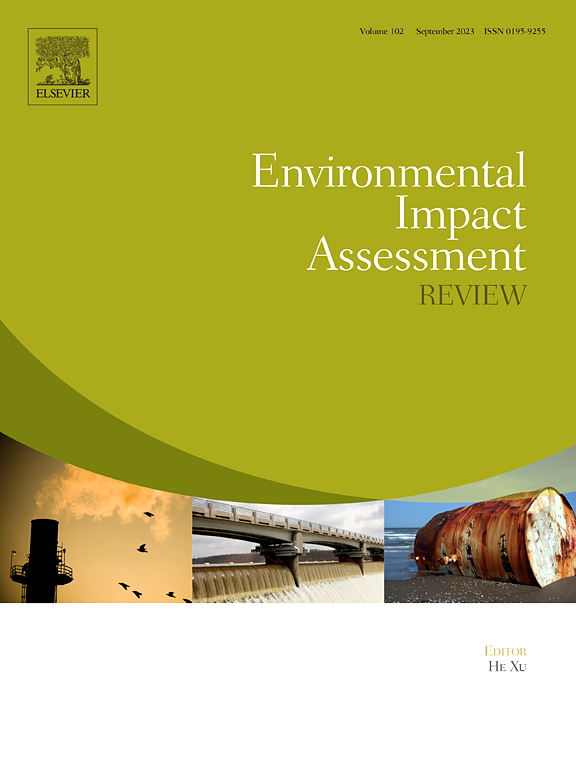Spatial disparity of life-cycle water use and greenhouse gas emissions from food waste resource conversion in China
IF 9.8
1区 社会学
Q1 ENVIRONMENTAL STUDIES
引用次数: 0
Abstract
With the construction of “Zero-Waste” City and the goals of “carbon peaking and carbon neutrality”, the resource utilization of food waste (FW) could not only reduce waste treatment pressure but also be converted into the high-value-added products in China. However, the selection of FW resource utilization technologies in China still remains contentious, with a notable absence of the region-specific guidance that adequately addresses local conditions. This study innovatively constructed a hybrid life cycle assessment framework, incorporating a multi-regional input-output table, to systematically evaluate the impact of spatial disparity on the environmental performance of eight FW resource utilization technologies. Results indicated that spatial disparity have a significant impact on water use and greenhouse gas emissions. Total water use and greenhouse gas (GHG) emissions of eight FW conversion technologies across 30 provinces ranged from 0.8 to 13.2 m3 t−1 and 72.6–573.0 kg CO2-eq t−1, respectively. Additionally, decomposition analysis presented that the sector of electricity and heat production was the primary driver of disparities across 30 provinces, with coefficients of variation ranging from 17.2 %–55.1 % for water consumption and 5.2 %–25.0 % for GHG emissions. Meanwhile, the sensitivity of water use or GHG emissions to electricity exhibited the consistent fluctuating trends but with varying amplitudes. Moreover, due to spatial teleconnection, the highest inter-provincial embodied water use and GHG emissions mainly occurred in Jiangsu and Inner Mongolia, respectively. This study not only emphasizes the importance of spatial disparity on the environmental analysis but also provides a theoretical foundation for formulating regional resource management and emission reduction policies.
中国食物垃圾资源化利用生命周期用水量及温室气体排放的空间分异
随着中国“零垃圾”城市建设和“碳调峰、碳中和”目标的提出,对食物垃圾进行资源化利用,不仅可以减少垃圾处理压力,还可以转化为高附加值产品。然而,在中国,FW资源利用技术的选择仍然存在争议,明显缺乏针对当地情况的区域具体指导。本研究创新性地构建了混合生命周期评价框架,结合多区域投入产出表,系统评价了空间差异对8种FW资源利用技术环境绩效的影响。结果表明,空间差异对水资源利用和温室气体排放有显著影响。30个省份的8种淡水转换技术的总用水量和温室气体排放量分别在0.8 ~ 13.2 m3 t−1和72.6 ~ 573.0 kg CO2-eq t−1之间。此外,分解分析表明,电力和热力生产部门是30个省份差异的主要驱动因素,水消耗的变异系数为17.2% - 55.1%,温室气体排放的变异系数为5.2% - 25.0%。同时,水资源利用和温室气体排放对电力的敏感性表现出一致的波动趋势,但幅度不同。此外,由于空间遥相关,省际隐含用水量和温室气体排放量最高的地区主要集中在江苏和内蒙古。该研究不仅强调了空间差异在环境分析中的重要性,而且为制定区域资源管理和减排政策提供了理论依据。
本文章由计算机程序翻译,如有差异,请以英文原文为准。
求助全文
约1分钟内获得全文
求助全文
来源期刊

Environmental Impact Assessment Review
ENVIRONMENTAL STUDIES-
CiteScore
12.60
自引率
10.10%
发文量
200
审稿时长
33 days
期刊介绍:
Environmental Impact Assessment Review is an interdisciplinary journal that serves a global audience of practitioners, policymakers, and academics involved in assessing the environmental impact of policies, projects, processes, and products. The journal focuses on innovative theory and practice in environmental impact assessment (EIA). Papers are expected to present innovative ideas, be topical, and coherent. The journal emphasizes concepts, methods, techniques, approaches, and systems related to EIA theory and practice.
 求助内容:
求助内容: 应助结果提醒方式:
应助结果提醒方式:


